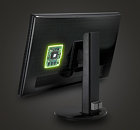- Joined
- Oct 9, 2007
- Messages
- 47,235 (7.55/day)
- Location
- Hyderabad, India
| System Name | RBMK-1000 |
|---|---|
| Processor | AMD Ryzen 7 5700G |
| Motherboard | ASUS ROG Strix B450-E Gaming |
| Cooling | DeepCool Gammax L240 V2 |
| Memory | 2x 8GB G.Skill Sniper X |
| Video Card(s) | Palit GeForce RTX 2080 SUPER GameRock |
| Storage | Western Digital Black NVMe 512GB |
| Display(s) | BenQ 1440p 60 Hz 27-inch |
| Case | Corsair Carbide 100R |
| Audio Device(s) | ASUS SupremeFX S1220A |
| Power Supply | Cooler Master MWE Gold 650W |
| Mouse | ASUS ROG Strix Impact |
| Keyboard | Gamdias Hermes E2 |
| Software | Windows 11 Pro |
NVIDIA's G-SYNC technology is rivaled by AMD's project Freesync, which is based on a technology standardized by the video electronics standards association (VESA), under Adaptive Sync. The technology lets GPUs and monitors keep display refresh rates in sync with GPU frame-rates, so the resulting output appears fluid. VESA's technology does not require special hardware inside standards-compliant monitors, and is royalty-free, unlike NVIDIA G-SYNC, which is based on specialized hardware, which display makers have to source from NVIDIA, which makes it a sort of a royalty.
When asked by Chinese publication Expreview on whether NVIDIA GPUs will support VESA adaptive-sync, the company mentioned that NVIDIA wants to focus on G-SYNC. A case in point is the display connector loadout of the recently launched GeForce GTX 980 and GTX 970. According to specifications listed on NVIDIA's website, the two feature DisplayPort 1.2 connectors, and not DisplayPort 1.2a, a requirement of VESA's new technology. AMD's year-old Radeon R9 and R7 GPUs, on the other hand, support DisplayPort 1.2a, casting a suspicion on NVIDIA's choice of connectors. Interestingly, the GTX 980 and GTX 970 feature HDMI 2.0, so it's not like NVIDIA is slow at catching up with new standards. Did NVIDIA leave out DisplayPort 1.2a in a deliberate attempt to check Adaptive Sync?

View at TechPowerUp Main Site
When asked by Chinese publication Expreview on whether NVIDIA GPUs will support VESA adaptive-sync, the company mentioned that NVIDIA wants to focus on G-SYNC. A case in point is the display connector loadout of the recently launched GeForce GTX 980 and GTX 970. According to specifications listed on NVIDIA's website, the two feature DisplayPort 1.2 connectors, and not DisplayPort 1.2a, a requirement of VESA's new technology. AMD's year-old Radeon R9 and R7 GPUs, on the other hand, support DisplayPort 1.2a, casting a suspicion on NVIDIA's choice of connectors. Interestingly, the GTX 980 and GTX 970 feature HDMI 2.0, so it's not like NVIDIA is slow at catching up with new standards. Did NVIDIA leave out DisplayPort 1.2a in a deliberate attempt to check Adaptive Sync?

View at TechPowerUp Main Site







